In this article, you’ll learn what is boiler draught. Its diagram, types, classification, advantages, and applications all are explained with pictures.
What is Boiler Draught?
Boiler draught is defined as the difference between absolute gas pressure at any point in a flow passage and the ambient (same elevation) atmospheric pressure. Draught is achieved by a small pressure difference which causes the flow of air or gas to take place. It is measured in millimeters (mm) of water.
The draught is one of the most essential systems of the thermal power plant which supports the required quantity of air for combustion and removes the burnt products from the system. To move the air through the fuel bed and to produce a flow of hot gases through the boiler economizer, preheater and chimney require a difference of pressure.
This difference of pressure to maintaining the constant flow of air and discharging the gases through the chimney to the atmosphere is known as draught. Draught can be achieved by the use of a chimney, fan, steam, air, jet, or a combination of these.
Read also: What are the Different Types of Steam Boilers?
Purpose of Boiler Draught
- To provide an adequate supply of air for fuel combustion.
- For throw out the exhaust gases of combustion from the combustion chamber.
- Discharge these gases to the atmosphere through the chimney.
Measurement of Draught
The amount of draught produced depends upon:
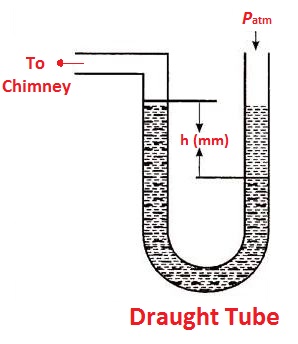
- The nature and depth of fuel at the furnace.
- Design of combustion chamber or firebox.
- The rate of combustion required.
- Resistance is allowed in the system due to baffles, tubes, superheaters, economizers, air pre-heaters, etc.
Classification of Boiler Draught
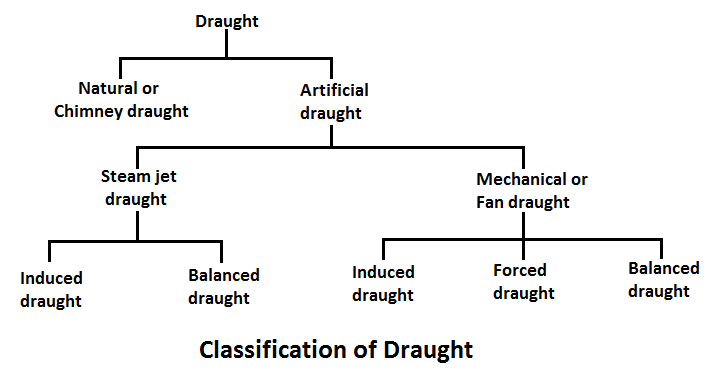
Types of Boiler Draught
In general, the draughts may be classified into the following two types,
- Natural Draught
- Artificial Draught
Natural Draught
The natural draught system employs a tall chimney as shown in the figure. The chimney is a vertical tubular masonry structure or reinforced concrete. It is formed to enclose a column of flue gases to produce the draught.
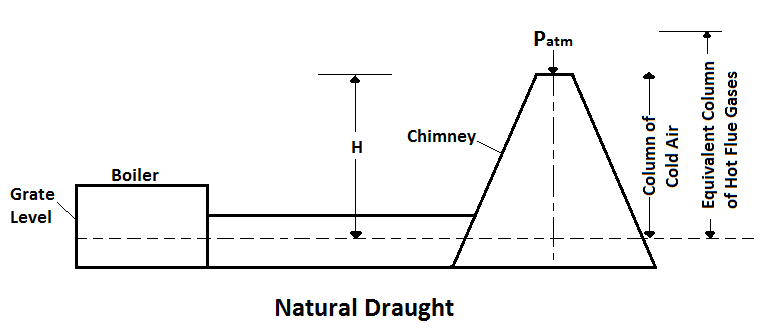
It removes the gases high enough to prevent air pollution. The draught is produced by this tall chimney due to the temperature difference between hot gases in the chimney and cold external air outside the chimney.
Advantages of Natural Draught
- It does not require any external power to produce the draught.
- The capital investment is less. The maintenance cost is low as there is no mechanical part.
- Chimney keeps the flue gases at a high place in the atmosphere which prevents the contamination of the atmosphere.
- It has a long life.
Disadvantages of Natural Draught
- The maximum pressure available for producing natural draught by the chimney is hardly 10 to 20 mm of water under normal atmospheric and flue gas temperatures.
- The available draught reduces with increases in outside air temperature and for generating enough draught, the exhaust gases have to be discharged at relatively high temperatures resulting in the loss of overall plant efficiency. Thus maximum utilization of Heat is not possible.
Artificial or Mechanical Draught
It has been seen that the draught produced by the chimney is affected by the atmospheric conditions. It has no flexibility and poor efficiency, and a tall chimney is required.
In most modern power plants, the draught applied must be freedom of atmospheric conditions, and It should have more flexibility (control) to bear the fluctuation loads on the plant.
Today’s steam power plants requiring 20 thousand tons of steam per hour would be impossible to run without the aid of draft fans.
A chimney of a reasonable height would be incapable of improving enough draft to eliminate the huge volume of air and gases ( 400 x 103 m 3 to 800 x 10 3 m 3 per minute). The further advantages of fans are to reduce the height of the chimney needed.
The draught required in the actual power plant is sufficiently high (300 mm of water) and to meet high draught requirements, some other system must be used, known as artificial draught.
The artificial is produced by a fan and it is known as dan (mechanical) draught. Mechanical draught is preferred for central power stations.
Advantages of Artificial or Mechanical Draught
- It is more economical and its control is easy.
- The desired value of draught can be produced by mechanical means which cannot produced using natural draught.
- It increases the rate of combustion by which low-grade fuel can also be used.
- It reduces the smoke level and increases the heat transfer co-efficient no flue gases side thus increasing the thermal efficiency of the boiler.
- In mechanical draught, It saves energy and the heat of flue gases can be best utilized by it.
- In this way, it reduces fuel consumption and makes boiler operation cheaper.
- It reduces the height of the chimney which now is only controlled by the requirement of pollution norms.
Disadvantages of Artificial or Mechanical Draught
- The initial cost of a mechanical draught system is high.
- Running costs are also high due to the requirement of electricity but that is easily compensated by the savings in fuel consumption.
- Maintenance cost is also at a higher rate.
- Noise level of boiler is also high due to noisy fan/blower etc.
Read also: Types of Boiler Mountings and Accessories
Types of Artificial or Mechanical Draught
The following are the two types of Artificial or Mechanical draught:
- Steam jet draught
- Mechanical or fan draught
Steam Jet Draught
It is a very simple and easy method of producing artificial draught without the need for an electric motor. It may be forced or induced depending on where the steam jet is installed. Steam under pressure is available in the boiler.
When a small position of steam is passed through a jet or nozzle, pressure energy converts to kinetic energy and steam comes out with a high velocity. This high-velocity steam carries, along with it, a large mass of air or flue gases and makes it flow through the boiler. Thus steam jet can be used to produce draught and it is a simple and cheap method.
Actually the steam jet is directed towards a fix direction and carries all its energy in kinetic form. It creates some vacuum in it’s surrounding and attracts the air of flue gases either by carrying along with it.
Thus it has the capacity to make the flow of the flue gases either by carrying or including towards chimney. It depends on the position of the steam jet.
Types of Steam Jet Draught
The following are the main two types of steam jet draught:
- Induced steam jet draught.
- Forced steam jet draught.
1. Induced Steam Jet Draught
The jet of steam is turned into a smoke box or chimney. The kinetic head of the steam is high but static head is low i.e., it produces a partial vacuum which brings the air through the grate, ash pit, flues and then to motor box and chimney.
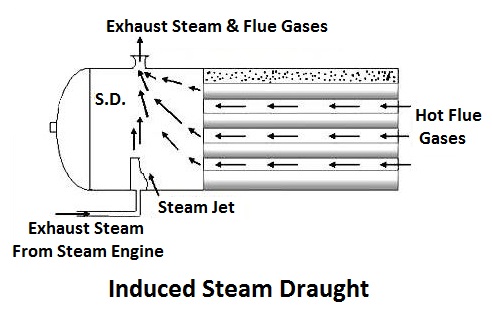
This type of induced steam jet draught arrangement is used in locomotive boilers. Here the steam jet is absorbing the exhaust gases through boiler so it is Induced Steam Jet Draught.
2. Forced Steam Jet Draught
Steam from the boiler after having been throttled to a gauge pressure of 1.5 to 2 bar is supplied to the jet or nozzle installed in the ash pit. The steam rising out of nozzles with a great velocity drags air by the fuel bed, furnace, flue passage and then to the chimney.
Here the steam jet is pushing or forcing the air and flue gases to flow through boiler hence it is forced steam jet draught.
Advantages of Induced Steam Jet Draught
- It is quite simple and cheap.
- The induced steam jet draught has the capability of using low-grade fuels.
- It occupies very less space.
- It is quite simple and cheap.
- The initial cost is low.
- Maintenance cost is low.
- Exhaust steam from the steam engine or turbine can be used easily in the steam jet draught.
Disadvantages of Steam Jet Draught
- It can operate only when some steam is generated.
- Draught produced very low.
2. Mechanical or Fan Draught
The draught, produced by means of a fan or blower, is known as mechanical draught or fan draught. The fan used is, generally, of centrifugal type and is driven by an electric motor.
In an induced fan draught a centrifugal fan is placed in the path of the flue gases before they enter the chimney. It draws the flue gases from the furnace and forces them up through the chimney. The action of this type of draught is similar to that of the natural draught.
In case of forced fan draught, the fan is placed before the grate, and the air is forced into the grate through the closed ash pit.
Types of Mechanical or Fan Draught
The following are the three types of mechanical or fan draught:
- Induced draught.
- Forced draught.
- Balanced draught.
1. Induced draught
In induced draught, the blower is placed near the base of the chimney instead of near the grate. The air is absorbed in the system by decreasing the pressure through the system below the atmosphere.
The induced draught fan sucks the burned gases from the furnace and the pressure inside the furnace is reduced below atmosphere and includes the atmospheric air to flow through the furnace.
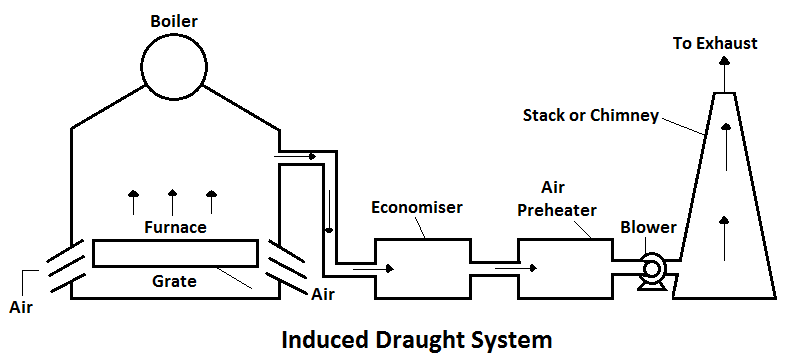
The action of the induced draught is related to the action of the chimney. The draught produced is free from the temperature of the hot gases, therefore, the gases may be released as cold as possible after recovering as much heat as possible in air-preheater and economiser.
2. Forced Draught
In a forced draught system, a blower is installed near the base of the boiler and air is forced to pass through the furnace, flues, economiser, air-preheater and to the stack.
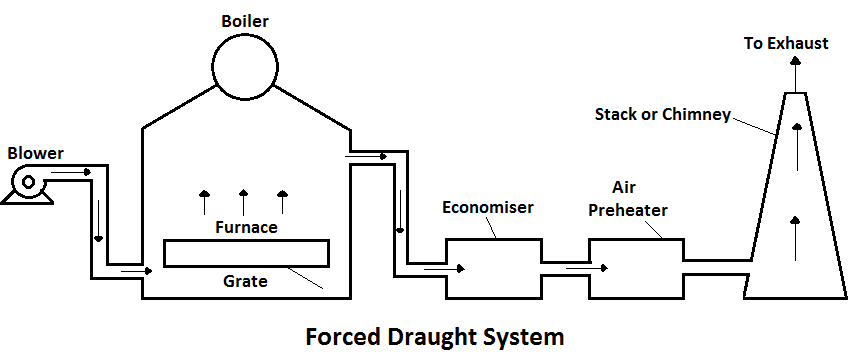
This draught system is known as positive draught system or forced draught system because the pressure and air are forced to flow through the system.
The arrangement of the system is shown in the figure. A stack or chimney is also in this system as shown in the figure but its function is to discharge gases high in the atmosphere to prevent the contamination. It is not much significant for producing draught, therefore, the height of the chimney may not be very much.
3. Balanced Draught
It is always better to use a combination of forced draught and induced draught instead of forced or induced draught alone. If the forced draught is applied alone, the furnace cannot be opened for firing or inspection because high-pressure air inside the furnace will quickly try to blow out and there is every possibility of blowing out the fire completely and furnace stops.
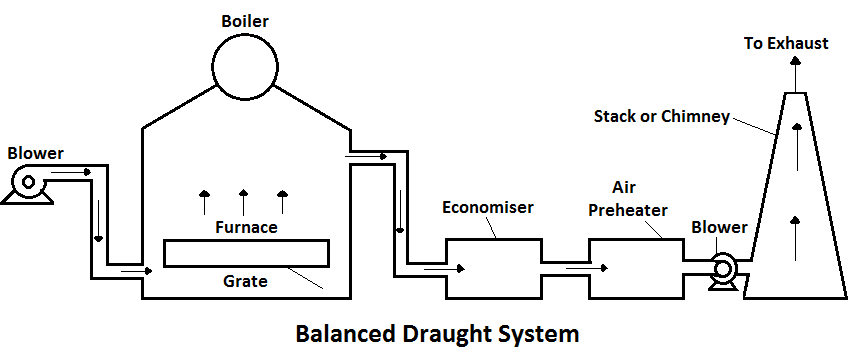
If the induced draught is used alone, then also furnace can not be opened either for firing inspection because the cold air will try to rush into the furnace as the pressure inside the furnace is under atmospheric pressure. This reduces the effective draught and dilutes the combustion.
Comparison Between Forced Draught and Induced Draught
| Forced Draught | Induced Draught |
| A fan or blower is placed before the grate. | A fan or blower is placed after the grate. |
| The pressure inside the flue gases is slightly more than atmospheric pressure. | The pressure inside the flue gases is slightly less than atmospheric pressure. |
| The fan requires less power. | The fan requires more power. |
| The flow of the flue gases through the boiler is more uniform. | The flow of the flue gases through the boiler is less uniform. |
| The danger of fire in case of leakage of flue gases. | No danger of fire in case of leakage of flue gases. |
Conclusion
That’s it. Thanks for reading. I hope I have covered everything about the “Boiler Draught” It would be helpful if you could let me know if there was anything I missed or if you have any doubts about anything I wrote.
Please share this article with your friends if you find it interesting.
Want free PDFs direct to your inbox? Then subscribe to our newsletter.
Read more in our blog:
- What is Benson Boiler? Parts, Working, Advantages
- Components and Working of Locomotive Boiler
- How does a Cochran boiler work?
FAQs
1. To ensure that there is a sufficient supply of air for fuel burning.
2. To remove the combustion exhaust gasses from the combustion chamber.
Natural draught is a draught produced by the densities of the hot gases inside the chimney and the cold atmospheric air outside.
1. Loss caused by the frictional resistance provided by the flue gas route to the flow of flue gases.
2. Loss is caused by bends in the gas flow circuit, which also provide flow resistance.
Boiler efficiency is the ratio of useful heat production to total energy input.
η = Q abs Q in.
where. η is boiler efficiency. Qabs is the useful heat absorbed (heat transferred to steam)
Sir brilliant bhaut Mazza aaya itni aasani se saare topic samaja diyee thankyou so much sir but I need pdf files of all the topic of mechanical plss help
Every article has a downloadable PDF, which you can easily download by clicking on it.